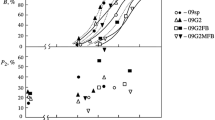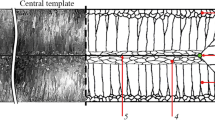Conclusions
Analysis of these data leads to the conclusion that the main reason for the sharp reduction of the ductility of heta resistant nickel alloys at 1150-1250° is enrichment of boundary areas with surface-active elements (carbon in particular), the effect increasing with the extent of alloying due to the high susceptibility to grain growth of the γ solid solution on highly alloyed alloys. The reduction of the specific surface of grain boundaries in the coarse-grained structure increases the concentration of surface-active elements in the boundaries.
This assumption is confirmed by electron fractographic data. The appearance of branced carbides in the fracture of aging nickel alloys (after slow cooling) coincides with the initial temperature of the drop in ductility and the initial solution of carbide phase and grain growth of the γ solid solution. With increasing alloying the branched carbides appear at lower temperatures.
The appearance of branched carbides in the fractures (intergranular) must be associated not with melting of the grain boundaries but with the solution of excess carbides and the segregation of carbon in the boundaries and also with subsequent precipitaion of carbides during slow cooling. With increasing temperatures the number of branched carbides in the fracture increases and at 1200–1250° they occupy almost the entire fracture surface. This evidently points to an incrase of carbon segregation and selective propagation of cracks along grain boundaries in places where it is concentrated.
However, the complex branched shape of carbides is due to the conditions of their formation in the practically two-dimentional plane of the fracture, especially since no dendrite-shaped carbides are observed in metallographic of electron microscopic analysis, i.e. branched carbides are observed only on the surface of the fracture after slow cooling.
Segregation of surface-active elements, especially carbon, reduces the binding force in grain boundaries inhibits stress relaxation when crack movements along boundaries stop or slow down, and lowers surface energy at the metal-rack interface.
Furthernore, the sharp grain growth of the γ solid solution observed at temperatures where the ductibility begins to drop leads to formation of flat boundaries at large sections, aong which crack movement is fcilitated. This facilities the process of fracture, as is indicated by the reduction of such characteristics as the work of crack initaition and work of crack propagation.
Similar content being viewed by others
Rights and permissions
About this article
Cite this article
Gulyaev, A.P., Bulavina, L.S. & Chernyak, G.S. High-Temperature ductility of heat-resistant Cr-Ni alloys. Met Sci Heat Treat 21, 358–363 (1979). https://doi.org/10.1007/BF00780774
Issue Date:
DOI: https://doi.org/10.1007/BF00780774




